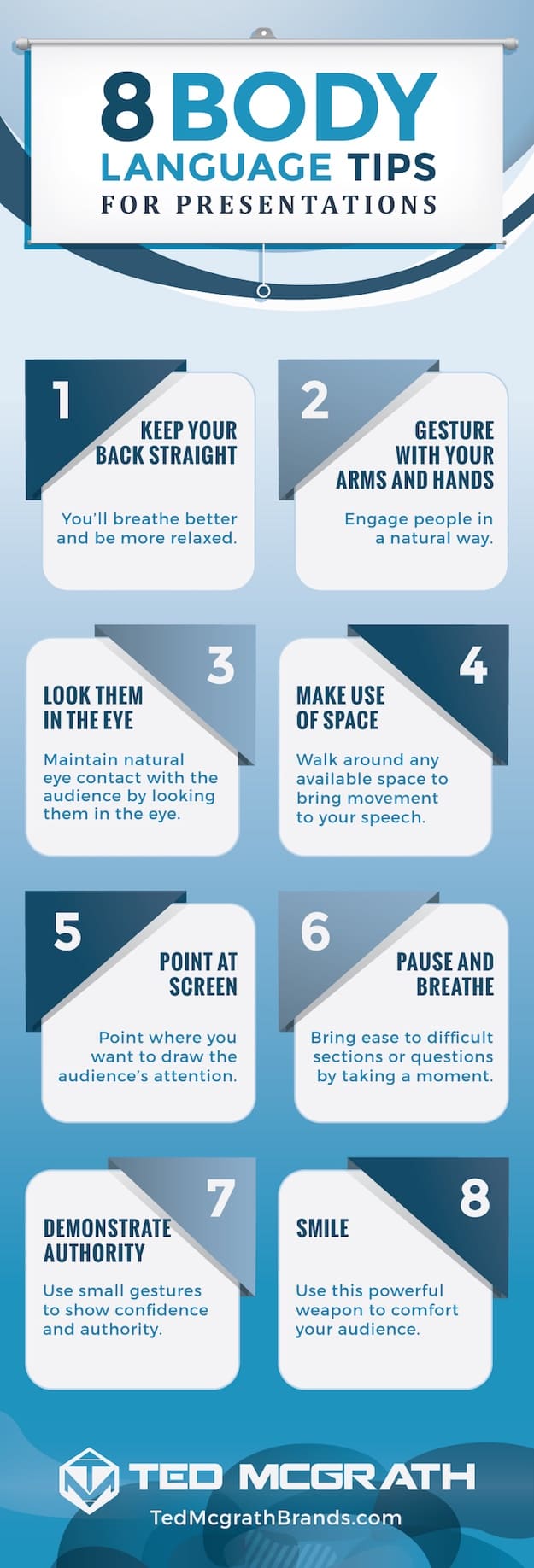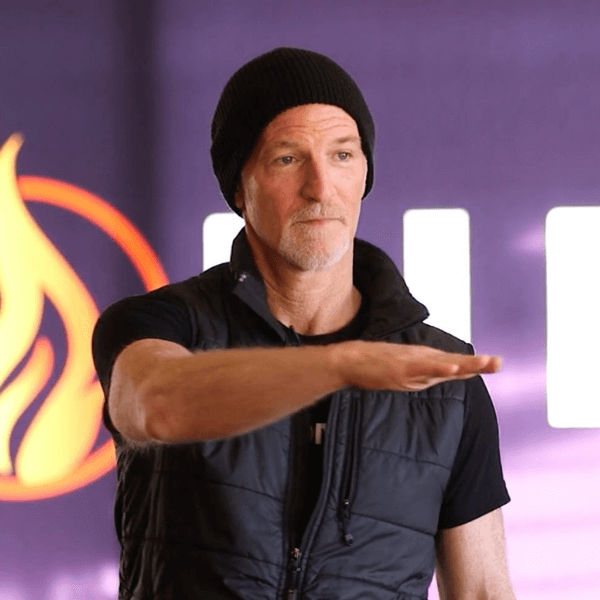8 Body Language Tips for Presentations

Believe it or not, your clients naturally pick up on microexpressions and other non-verbal cues whenever you communicate with them face to face. Things like your posture and hand gestures can spell the difference between success and failure in your interviews and presentations. Today, I will help improve your communication skills by sharing with you my 8 body language tips for presentations.
8 Body Language Tips to Improve Communication Skills
These eight points explain the right ways to use body language signals. You can apply them whether you’re talking to a standing-room-only crowd or to a smaller audience. Through these, you’ll learn how to command presence and authority. You can match your words with your actions, and be persuasive and believable. Best of all, you’ll give your confidence a boost!
1. Keep Your Back Straight

One of the best ways to improve business presentation skills is to stand straight. A presenter who slouches during an in-house training session silently discourages his audience even if his PowerPoint slides are great. So push your shoulders back and bring them up, lift your head, and keep your back aligned. This is a powerful body language that brings the attention of your audience to you.
Keeping your back straight will also enhance the amount of oxygen you breathe. In turn, this boosts your alertness and focus. A good posture also makes you appear younger and leaner, and it reduces the feeling of tiredness and stress.
2. Gesture with Your Arms and Hands

Some of the body language tips often ignored during presentations are hand gestures and facial expressions. Granted, too much of these are distracting and they weaken the entire speech. But, you can convey your message better when you supplement your words with actions and don’t forget to motion with your arms now and then. Remember, we’re visual people. When we engage our senses at the same time, we learn ideas fast.
For hand gestures, keeping them as natural as possible is important. When you practice your presentation—and you should—try looking at yourself in the mirror. Check your non-verbal communication through your facial expressions and gestures. Do they match what you’re saying? Are they exaggerated?
3. Look Them in the Eye
https://twitter.com/ted_mcgrath/status/946500103434637312
Communication is a two-way process: somebody listens while the other speaks. While everyone has the tendency to talk, few seem to care to listen. So, how do you ensure your audience will listen? Look them in the eye. Establish a relationship while you’re in front of them or on the stage. Use eye contact to bring their attention towards you and what you’re saying.
It’s also a subtle way of asking your audience if they understand your message. By looking them in the eye, you can gauge the audience’s level of interest, too.
Looking a person in the eye also signals trust and honesty. Who goes on to a job interview and never looks their possible employers in the eye? It’s always a good idea to maintain a level of eye contact.
But remember — you’re making eye contact, not ogling or staring at them. Avoid looking at someone for more than three seconds. Shift your gaze from one person to another. Try looking at the people in the back as well.
4. Make Use of Space

If you watch tech conferences, you’ll notice that tech speakers tend to walk around the stage. For one, doing this can actually help you relax. As you move, you can pause, take deep breaths, and collect your thoughts.
Also, by walking around, you ensure you’re covering every corner of your platform. This way, you won’t miss any part of the audience. But again, too much walking can disrupt your speech! So practice your pace before your event. Learn to stand still in certain areas.
5. Point at the Screen
https://twitter.com/ted_mcgrath/status/966034479155425282
Another one of the eight body language tips on the list is to point at the screen. Do this to emphasize a reference or some bullet points to your audience. This is also a non-verbal way of drawing their attention back to you.
Most people use their finger to point. But during your PowerPoint presentations, make use of a laser pointer or a stick. These objects are far more visible so that even people at the back can see where you’re pointing at.
Read Also: How To Master A Stage Presentation And Become An Effective Speaker
6. Pause and Breathe

When you speak fast, you reduce the impact of your message. Plus, it makes you sound anxious or stressed. Your audience won’t be able to understand what you’re saying. And when this happens, they either refer to their notes or ignore you. The bottom line is, they won’t listen!
But when you pause and breathe, you can communicate with your audience better. It’ll also prevent you from stammering so you can have a confident conversation. Taking a moment from speaking will help you remember your notes. Then you can navigate the complex parts of your message and answer hard questions.
But, there’s a huge difference between a pause and dead air. The latter is a telltale sign your speech is getting boring. A pause must not last longer than a breath. Learn to break breaths using open gestures and moving on to your next point.
And here’s a pro tip: avoid taking deep breaths that raise your shoulders once you’re in front of the audience. This can give off the impression that you’re exhausted. So if you feel the need to take deep breaths, be as subtle as possible.
7. Demonstrate Authority
https://twitter.com/ted_mcgrath/status/973654092538105857
A fluent way of talking can only get you so far. If you want to share your message and inspire action, you need to be more than persuasive. You must look, feel, and sound authoritative.
To do this, you need to apply my previous body language tips, such as correct posture, some hand gestures, and efficient use of the platform. But, let’s add some more: subtle body movements. These include the following actions:
- Nod to your audience
- Put your hands down at your sides when not in use
- Control the swinging of your arms while walking
8. Smile

Speeches, talks, and business presentations must be a pleasant experience for both the listener and the speaker. If you’re the latter, it’s your responsibility to make your audience feel relaxed and comfortable. When you do this, they are more likely to be receptive to your message.
There are many things you can do to ease the tension. You can have ice-breakers, tell a few anecdotes, or add humor to your speech. But, the easiest thing to do is to have a genuine smile on your face as you conduct your talk. It not only lightens the mood, but it also encourages the audience to connect with you.

So, are you ready to wow your clients? I can’t stress enough the importance of a presentation done right. You can achieve it with positive body language and the right amount of practice. Perfect your skills by applying these body language tips the next time you hit the stage!
Do you have your own body language tips based on experience? Share them with the rest of the community!
Up Next: My Ultimate Public Speaking Guide
Editor’s Note: This post was originally published in June 2017 and has been updated for quality and relevancy.
ABOUT THE AUTHOR





